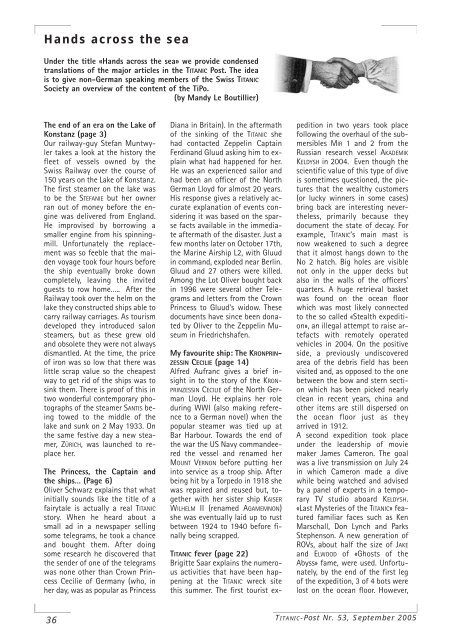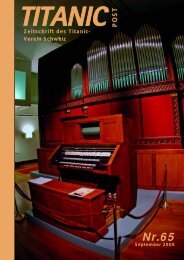Zeitschrift des Titanic-Verein Schweiz - Wordpress Wordpress
Zeitschrift des Titanic-Verein Schweiz - Wordpress Wordpress
Zeitschrift des Titanic-Verein Schweiz - Wordpress Wordpress
Erfolgreiche ePaper selbst erstellen
Machen Sie aus Ihren PDF Publikationen ein blätterbares Flipbook mit unserer einzigartigen Google optimierten e-Paper Software.
Hands across the sea<br />
Under the title «Hands across the sea» we provide condensed<br />
translations of the major articles in the TITANIC Post. The idea<br />
is to give non-German speaking members of the Swiss TITANIC<br />
Society an overview of the content of the TiPo.<br />
(by Mandy Le Boutillier)<br />
The end of an era on the Lake of<br />
Konstanz (page 3)<br />
Our railway-guy Stefan Muntwyler<br />
takes a look at the history the<br />
fleet of vessels owned by the<br />
Swiss Railway over the course of<br />
150 years on the Lake of Konstanz.<br />
The first steamer on the lake was<br />
to be the STEFANIE but her owner<br />
ran out of money before the engine<br />
was delivered from England.<br />
He improvised by borrowing a<br />
smaller engine from his spinningmill.<br />
Unfortunately the replacement<br />
was so feeble that the maiden<br />
voyage took four hours before<br />
the ship eventually broke down<br />
completely, leaving the invited<br />
guests to row home….. After the<br />
Railway took over the helm on the<br />
lake they constructed ships able to<br />
carry railway carriages. As tourism<br />
developed they introduced salon<br />
steamers, but as these grew old<br />
and obsolete they were not always<br />
dismantled. At the time, the price<br />
of iron was so low that there was<br />
little scrap value so the cheapest<br />
way to get rid of the ships was to<br />
sink them. There is proof of this in<br />
two wonderful contemporary photographs<br />
of the steamer SANTIS being<br />
towed to the middle of the<br />
lake and sunk on 2 May 1933. On<br />
the same festive day a new steamer,<br />
ZÜRICH, was launched to replace<br />
her.<br />
The Princess, the Captain and<br />
the ships… (Page 6)<br />
Oliver Schwarz explains that what<br />
initially sounds like the title of a<br />
fairytale is actually a real TITANIC<br />
story. When he heard about a<br />
small ad in a newspaper selling<br />
some telegrams, he took a chance<br />
and bought them. After doing<br />
some research he discovered that<br />
the sender of one of the telegrams<br />
was none other than Crown Princess<br />
Cecilie of Germany (who, in<br />
her day, was as popular as Princess<br />
Diana in Britain). In the aftermath<br />
of the sinking of the TITANIC she<br />
had contacted Zeppelin Captain<br />
Ferdinand Gluud asking him to explain<br />
what had happened for her.<br />
He was an experienced sailor and<br />
had been an officer of the North<br />
German Lloyd for almost 20 years.<br />
His response gives a relatively accurate<br />
explanation of events considering<br />
it was based on the sparse<br />
facts available in the immediate<br />
aftermath of the disaster. Just a<br />
few months later on October 17th,<br />
the Marine Airship L2, with Gluud<br />
in command, exploded near Berlin.<br />
Gluud and 27 others were killed.<br />
Among the Lot Oliver bought back<br />
in 1996 were several other Telegrams<br />
and letters from the Crown<br />
Princess to Gluud's widow. These<br />
documents have since been donated<br />
by Oliver to the Zeppelin Museum<br />
in Friedrichshafen.<br />
My favourite ship: The KRONPRIN-<br />
ZESSIN CECILIE (page 14)<br />
Alfred Aufranc gives a brief insight<br />
in to the story of the KRON-<br />
PRINZESSIN CECILIE of the North German<br />
Lloyd. He explains her role<br />
during WWI (also making reference<br />
to a German novel) when the<br />
popular steamer was tied up at<br />
Bar Harbour. Towards the end of<br />
the war the US Navy commandeered<br />
the vessel and renamed her<br />
MOUNT VERNON before putting her<br />
into service as a troop ship. After<br />
being hit by a Torpedo in 1918 she<br />
was repaired and reused but, together<br />
with her sister ship KAISER<br />
WILHELM II (renamed AGAMEMNON)<br />
she was eventually laid up to rust<br />
between 1924 to 1940 before finally<br />
being scrapped.<br />
TITANIC fever (page 22)<br />
Brigitte Saar explains the numerous<br />
activities that have been happening<br />
at the TITANIC wreck site<br />
this summer. The first tourist expedition<br />
in two years took place<br />
following the overhaul of the submersibles<br />
MIR 1 and 2 from the<br />
Russian research vessel AKADEMIK<br />
KELDYSH in 2004. Even though the<br />
scientific value of this type of dive<br />
is sometimes questioned, the pictures<br />
that the wealthy customers<br />
(or lucky winners in some cases)<br />
bring back are interesting nevertheless,<br />
primarily because they<br />
document the state of decay. For<br />
example, TITANIC's main mast is<br />
now weakened to such a degree<br />
that it almost hangs down to the<br />
No 2 hatch. Big holes are visible<br />
not only in the upper decks but<br />
also in the walls of the officers'<br />
quarters. A huge retrieval basket<br />
was found on the ocean floor<br />
which was most likely connected<br />
to the so called «Stealth expedition»,<br />
an illegal attempt to raise artefacts<br />
with remotely operated<br />
vehicles in 2004. On the positive<br />
side, a previously undiscovered<br />
area of the debris field has been<br />
visited and, as opposed to the one<br />
between the bow and stern section<br />
which has been picked nearly<br />
clean in recent years, china and<br />
other items are still dispersed on<br />
the ocean floor just as they<br />
arrived in 1912.<br />
A second expedition took place<br />
under the leadership of movie<br />
maker James Cameron. The goal<br />
was a live transmission on July 24<br />
in which Cameron made a dive<br />
while being watched and advised<br />
by a panel of experts in a temporary<br />
TV studio aboard KELDYSH.<br />
«Last Mysteries of the TITANIC» featured<br />
familiar faces such as Ken<br />
Marschall, Don Lynch and Parks<br />
Stephenson. A new generation of<br />
ROVs, about half the size of JAKE<br />
and ELWOOD of «Ghosts of the<br />
Abyss» fame, were used. Unfortunately,<br />
by the end of the first leg<br />
of the expedition, 3 of 4 bots were<br />
lost on the ocean floor. However,<br />
36<br />
TITANIC-Post Nr. 53, September 2005



